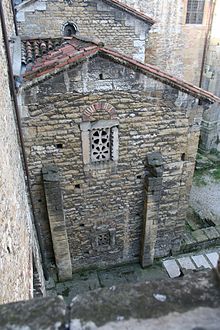Cámara Santa
| Holy chamber of Oviedo Cámara Santa de Oviedo (in Spanish) | |
|---|---|
 | |
| Religion | |
| Affiliation | Roman Catholic |
| Ecclesiastical or organizational status | Chapel |
| Location | |
| Location | Oviedo (Asturias), Spain |
| Geographic coordinates | 43°21′44″N 5°50′34.37″W / 43.36222°N 5.8428806°W |
| Architecture | |
| Type | Church |
| Style | Pre-Romanesque |
| Completed | 9th century |
| Type | Cultural |
| Criteria | ii, iv, vi |
| Designated | 1985 (9th session) |
| Parent listing | Monuments of Oviedo and the Kingdom of the Asturias |
| Reference no. | 312-004 |
| Region | Europe and North America |
| Website | |
| Official Website | |
The Holy chamber of Oviedo (Spanish: Cámara Santa de Oviedo, also known as the chapel of St. Michael) is a Roman Catholic pre-Romanesque church in Oviedo, Spain, built next to pre-romanesque Tower of San Miguel of the city's cathedral. Nowadays, the church occupies the angle between the south arm of the cathedral transept and a side of the cloister.
It was built during the 9th century as a palace chapel for King Alfonso II of Asturias and the church of San Salvador of Oviedo. Apart from acting as royal chapel, the Holy Chamber was built to house the jewels and relics of the cathedral of San Salvador in Oviedo, a function it continues to have 1200 years later. Some of these jewels were donated by the Kings Alfonso II and Alfonso III, and represent extraordinary gold artifacts of Asturian Pre-Romanesque, brought from Toledo after the fall of the Visigothic kingdom.
Consequently, the cathedral of Oviedo was also called Sancta Ovetensis;[1] owing to quantity and quality of relics contained in the Cámara Santa (English: Holy Chamber). The Holy Chamber remains as the only sample of the early medieval complex. It was built as a relics' room to keep the different treasures associated with the Kingdom of Asturias (Cross of the Angels, Victory Cross, Agate box, Arca Santa and Sudarium of Oviedo), brought from Jerusalem to Africa, and after several translations was finally deposited at Oviedo by Alfonso II of Asturias.
It was declared a World Heritage Site by UNESCO in December 1998.
Architecture
[edit]
It consists of two overlapping aisles with a barrel vault; the crypt or lower floor has a height of 2.30 metres, and is dedicated to St. Leocadia, containing several tombs of other martyrs.
The crypt of St. Leocadia is a rectangular chamber with walls of rubble. It has a rude semicircular unbroken barrel vault, barely 80 cm high at the crown. Originally it was lighted by very narrow windows, mere loopholes, splayed internally, in the side walls, and by one large window at the east end.[2]
The Camara Santa, as its ancient parts show, consists of a square eastern sanctuary, attached to a rectangular cella . The sanctuary has a low barrel vault. Its frontal arch is carried by two marble columns of Roman origin. A pair of similar columns decorate the east window, which internally has an arch, but externally a square head with a rude brick relieving arch, just like the east window of the crypt below. Their capitals have a Corinthian style, with leaves packed into shells, relief being produced by the drill, and recall an angle capital in San Julián de los Prados.
On the upper floor, the Camara Santa dedicated to St. Michael, was extended in the 12th century, elongating the central section to six metres, a reconstruction that also provided it with its current decoration, a masterpiece of Spanish Romanesque. From an architectural point of view, the Holy Chamber's construction solved one of the greatest problems of Asturian Pre-Romanesque: the vaulting of two overlapping spaces, later used in the buildings of Ramiro I of Asturias.
Sudarium of Oviedo
[edit]The Sudarium of Oviedo, or Shroud of Oviedo, also cloth of Oviedo, is a bloodstained cloth kept in the Arca Santa for which the chapel was built.[3] The Sudarium (Latin for sweat cloth) is claimed to be the cloth wrapped around the head of Jesus Christ after he died.[4] There are notable congruencies with a number of related acheiropoieta images such those of the Turin and Manoppello.[5]
See also
[edit]Notes
[edit]- ^ Ford, Richard (1855). "The Asturias". A handbook for travellers in Spain. Vol. II. John Murray. pp. 635–651.
- ^ Rivoira, Giovanni Teresio (1918). Moslem architecture : its origins and development. London: Oxford University Press.
- ^ Bennett, Janice (January 2005). Sacred Blood, Sacred Image: The Sudarium of Oviedo, New Evidence for the Authenticity of the Shroud of Turin. Ignatius Press. ISBN 978-0-9705682-0-5. Retrieved 21 October 2010.
- ^ Byssus and pure linen – Comparing the cloths Archived 2013-02-12 at the Wayback Machine Multimedia comparison of the cloth of Oviedo and the sudarium of Manoppello, Texts: Blandina Paschalis Schlömer
- ^ The Rediscovered Face - 1 first of four installments of an audiovisual presentation relating the holy image with a number of ancient predecessors, YouTube, access date March 2013.
References
[edit]- García de Castro Valdés, César (2004). "Cripta de San Leocadia". Arte Prerrománico de Asturias (in Spanish). Oviedo: Ediciones Nobel. ISBN 84-8459-181-6.
- García de Castro Valdés, César (2004). "Cámara Santa". Arte Prerrománico de Asturias (in Spanish). Oviedo: Ediciones Nobel. ISBN 84-8459-181-6.
- Rivoira, Giovanni Teresio (1918). Moslem architecture : its origins and development. London: Oxford University Press.
- Menendez Pidal, Luis (1960). "La Cámara Santa,su destrucción y reconstrucción" (PDF). Boletin del Insituto de Estudios Asturianos (in Spanish). 39 (1): 3–34. ISSN 0020-384X. Archived from the original (PDF) on 2012-04-26. Retrieved 2011-12-03.
- Fernandez Buelta, Jose Maria (1949). "La Cámara Santa de Oviedo. Su primitiva construcción,su destrucción y reconstrucción" (PDF). Boletin del Insituto de Estudios Asturianos (in Spanish). 6 (3): 51–116. ISSN 0020-384X. Archived from the original (PDF) on 2012-04-26.


